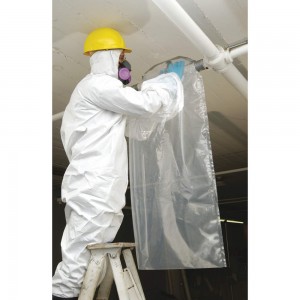If you are not in the asbestos inspection or abatement industry, you probably aren’t familiar with terms and phrases used when discussing asbestos testing or removal. This is not an exhaustive list, but here are eight terms you may commonly hear when discussing environmental concerns in your home with a professional.
Asbestos Testing
Samples – These are pieces of a material that is “suspect” that are safely collected and transported to a laboratory for analysis. (for more info on different types of microscopy click here – WARNING PDF FILE.) And, yes, the only way to truly know that a material contains asbestos is  the have it analyzed under a microscope (unless you have the original packaging that plainly tells you CONTAINS ASBESTOS!)
the have it analyzed under a microscope (unless you have the original packaging that plainly tells you CONTAINS ASBESTOS!)
Hot – That is our way in the industry of saying something contains asbestos. It’s much cooler than saying “asbestos containing.” Try it. You’ll sound like a pro.
Friable and Non Friable – we’re going to quote the EPA on this one (much more info can be found here.) –
Q. What is friable and non-friable asbestos containing material?
A. Friable ACM is any material containing more than one percent asbestos (as determined by Polarized Light Microscopy) that, when dry, may be crumbled, pulverized, or reduced to powder by hand pressure. Non-friable ACM is any material containing more than one percent asbestos (as determined by Polarized Light Microscopy) that, when dry, cannot be crumbled, pulverized, or reduced to powder by hand pressure. Under the Asbestos NESHAP, non-friable ACM is divided into two categories. Category I non-friable ACM are asbestos-containing resilient floor coverings (commonly known as vinyl asbestos tile (VAT)), asphalt roofing products, packaging and gaskets. These materials rarely become friable. All other non-friable ACM are considered category II non-friable ACM.
Confused? Basically, friable asbestos can be crushed or pulverized easily by hand when dry. Non friable cannot. Which doesn’t mean you can drill through, cut, or disturb without releasing fibers. You most definitely will release fibers. Don’t do that.
Asbestos Abatement
Containment / Critical Barrier – a containment is a means of sealing an area with 4 to 6 mil poly (depending on type of material) to prevent asbestos fibers from contaminating adjacent areas when removing asbestos. Only licensed personnel area allowed in a containment area with proper personal protective equipment (PPE). According to OSHA CFR 1926.1101(b), “Critical Barrier” means one or more layers of plastic sealed over all openings into a work area or any other similarly placed physical barrier sufficient to prevent airborne asbestos in a work area from migrating to an adjacent area. It’s what we do to keep other areas safe during removal, even when removing non friable materials.
Glove bag – A glove bag is an amazing invention that allows for a mini containment of sorts (see above for containment) and has built-in gloves to allow safe removal of thermal system insulation from pipes.

Glovebag (photo courtesy of Grainger.com)
Encapsulation/Entombment – This is always an option for ACM that is in good shape and won’t be disturbed by renovations or demolition. To encapsulate is to cover with a protective layer, usually an abatement industry specific compound for locking down fibers. Entombment is covering up the ACM with walls, another layer of flooring ,etc. PLEASE get professional advice before attempting either option. A little time invested on the front end could prevent possible contamination of your living space later.
Negative Air Machine – This is also sometimes called an “air scrubber.” The purpose of this machine is to change and filter the air in a workspace using HEPA filtration, which effectively filters 99.97% of particles at .03 microns. At a minimum the air in your space to be abated should completely change every 15 minutes. Negative air also indicates that the space will be under negative pressure, meaning that the air flows in and can’t escape without being “scrubbed” through the HEPA filter.
Still have questions?
Give us a call today at 636-477-5909.
We are always ready to assist homeowners in the Saint Louis Metro Area, in both Missouri and Illinois.
